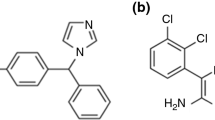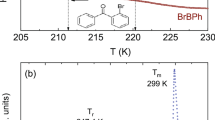Abstract
Purpose. To show that thermally stimulated depolarization currents (TSDC), which is a dielectric experimental technique relatively unknown in the pharmaceutical scientists community, is a powerful technique to study molecular mobility in pharmaceutical solids, below their glass transition temperature (Tg). Indomethacin (Tg = 42°C) is used as a model compound.
Methods. TSDC is used to isolate the individual modes of motion present in indomethacin, in the temperature range between −165°C and +60°C. From the experimental output of the TSDC experiments, the kinetic parameters associated with the different relaxational modes of motion were obtained, which allowed a detailed characterization of the distribution of relaxation times of the complex relaxations observed in indomethacin.
Results. Two different relaxational processes were detected and characterized: the glass transition relaxation, or α-process, and a sub-Tg relaxation, or secondary process. The lower temperature secondary process presents a very low intensity, a very low activation energy, and a very low degree of cooperativity. The fragility index (Angell's scale) of indomethacin obtained from TSDC data is m = 64, which can be compared with other values reported in the literature and obtained from other experimental techniques.
Conclusions. TSDC data indicate that indomethacin is a relatively strong glass former (fragility similar to glycerol but lower than sorbitol, trehalose, and sucrose). The high-resolution power of the TSDC technique is illustrated by the fact that it detected and characterized the secondary relaxation in indomethacin, which was not possible by other techniques.
Similar content being viewed by others
REFERENCES
B. C. Hancock and G. Zografi. Characteristics and significance of the amorphous state in pharmaceutical systems. J. Pharm. Sci. 86:1-12 (1997).
D. Q. M. Craig, P. G. Royal, V. L. Kett, and M. L. Hopton. The relevance of amorphous state to pharmaceutical dosage forms: glassy drugs and freeze dried systems. Int. J. Pharm. 179:179-207 (1999).
S. L. Shambling, X. Tang, L. Chang, B. C. Hancock, and M. J. Pikal. Characterization of the time scales of molecular motion in pharmaceutically important glasses. J. Phys. Chem. B 103:4113-4121 (1999).
V. Adronis and G. Zografi. Molecular mobility of supercooled amorphous indomethacin, determined by dynamical mechanical analysis. Pharm. Res. 14:410-414 (1997).
V. Adronis and G. Zografi. The molecular mobility of supercooled amorphous indomethacin as a function of temperature and relative humidity. Pharm. Res. 15:835-842 (1998).
R. He and D. Q. M. Craig. An investigation into the thermal behaviour of an amorphous drug using low frequency dielectric spectroscopy and modulated temperature differential scanning calorimetry. J. Pharm. Pharmacol. 53:41-48 (2001).
V. Adronis and G. Zografi. Crystal nucleation and growth of indomethacin polymorphs from the amorphous state. J. Non-Cryst. Solids 271:236-248 (2000).
G. Teyssèdre and C. Lacabanne. Some considerations about the analysis of thermostimulated depolarisation peaks. J. Phys. D: Appl. Phys. 28:1478-1487 (1995).
N. T. Correia, C. Alvarez, J. J. Moura Ramos, and M. Descamps. Molecular motions in molecular glasses as studied by thermally stimulated depolarisation currents (TSDC). Chem. Phys. 252: 151-163 (2000).
C. Alvarez, N. T. Correia, J. J. Moura Ramos, and A. C. Fernandes. Glass transition relaxation and fragility in a side-chain liquid crystalline polymer: a study by TSDC and DSC. Polymer 41:2907-2914 (2000).
N. T. Correia, C. Alvarez, J. J. Moura Ramos, and M. Descamps. Glass transition relaxation and fragility in the molecular glass forming m-toluidine: a study by thermally stimulated depolarisation currents. J. Chem. Phys. 113:3204-3211 (2000).
R. Chen and Y. Kirsch. Analysis of Thermally Stimulated Processes, Pergamon Press, Oxford, 1981.
N. T. Correia, J. M. Campos, and J. J. Moura Ramos. Molecular motions in chloropentamethylbenzene: a thermally stimulated depolarisation currents study. J. Chem. Soc., Faraday Trans. 93: 157-163 (1997).
R. Bohmer, K. L. Ngai, C. A. Angell, and D. J. Plazek. Nonexponential relaxations in strong and fragile glass formers. J. Chem. Phys. 99:4201-4209 (1993).
J. J. Moura Ramos. Molecular motions and phase transformations in solid 1-cyanoadamantane: a thermally stimulated discharge currents study. Mol. Phys. 90:235-242 (1997).
C. A. Angell. Entropy and fragility in supercooling liquids. J. Res. Natl. Inst. Stand. Technol. 102:171-185 (1997).
N. T. Correia, C. Alvarez, J. J. Moura Ramos, and M. Descamps. The β-α branching in D-sorbitol as studied by thermally stimulated depolarisation currents (TSDC). J. Phys. Chem. B 105: 5663-5669 (2001).
N. Lebrun, O. Bustin, J. C. van Miltenburg, L. Carpentier, and M. Descamps. 24èmes Journées d'Equilibre Entre Phases (JEEP 98), Nancy (France), 1–2 April, 1998.
O. Bustin and M. Descamps. Slow structural relaxations of glass-forming maltitol by modulated DSC calorimetry. J. Chem. Phys. 110:10982-10992 (1999).
Author information
Authors and Affiliations
Rights and permissions
About this article
Cite this article
Correia, N.T., Moura Ramos, J.J., Descamps, M. et al. Molecular Mobility and Fragility in Indomethacin: A Thermally Stimulated Depolarization Current Study. Pharm Res 18, 1767–1774 (2001). https://doi.org/10.1023/A:1013339017070
Issue Date:
DOI: https://doi.org/10.1023/A:1013339017070




